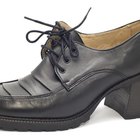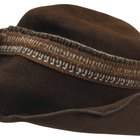
Stampede strings are a set of long strings that attach to a cowboy hat at the point where the top and brim of the hat meet. The strings are worn under the chin to prevent the hat from blowing off when on a running horse or when out in the wind. It is called a stampede string because it prevents the hat from being trampled by a stampede when working cattle by holding it tight to the cowboy’s head. Many rodeo professionals and ranchers add stampede strings to their cowboy hats to prevent them from falling off when working. There are two basic styles of stampede strings: a loop string and a cotter pin stampede string.
Loop Style
Put on your hat and use a permanent marker to make a small mark on each side of the underside of the hat’s brim. It should be even with the front of your ear or the back of your jaw line, parallel to where you want the string to lie along your face.
Take the hat off and gently push an awl up through the bottom of the hat creating a small hole. The hole should be on the mark you made, at the point where the bowl of the hat and the brim join.
Wiggle the awl back and forth or in circles to widen the hole. Continue widening the hole until it is large enough for the string to pass through.
Make a matching hole on the opposite side of the hat. Use the same process to create and widen the hole.
Run a short length of fishing string through the loop at the top of the stampede string for the left side of the hat.
Run the fishing string up through the hole in the left side of the hat from the bottom side of the brim and use it to pull the stampede string up through the hole.
Continue pulling the loop up through the brim of the hat until the loop is large enough to go over the crown of the hat.
Open the loop and place it over the top of the hat so that it rests where the top of the hat and the brim meet. Pull down on the stampede string under the brim to tighten the loop.
Repeat for the right side of the hat, running fishing string through the loop, pulling the loop up through the brim of the hat, and securing the loop over the crown.
Tie the string on the tasseled end under the chin to secure the hat during use.
Cotter-Pin Style
Put the hat on your head and mark the place where you want the cotter-pins with a permanent marker or a piece of chalk.
Push the cutter pins between the body of the hat and the sweat band on the inside of the hat. Slide the cotter pins between the stitches that attach the band to the hat. Cutting the strand can cause the stitching to unravel and the band to come out of the hat and should be completely avoided.
Turn down the sweatband so that the cotter-pins are exposed and you have easy access to them.
Flatten the cotter-pins out so that they lay smoothly against the lining of the hat. Then turn the sweat band back up into position.
Pull down on the stampede strings so that the cutter pins are tight and laying against the very bottom edge of the sweat band. Tie the cords under the chin to secure the hat on your head.
Related Articles

How to Protect Your Hairdo in the Wind

How to Keep Your Hat on Your Head ...

How to Insert a Tilley Hat Cord

How to Restore the Shape of a Floppy Hat

How to Replace a Sweatband on a Cowboy ...

How to Resize a Straw Cowboy Hat

How to Break in a Cowboy Hat

How to Make a Cowboy Hat Smaller

How to Hold a Band on a Cowboy Hat

How to Keep Your Cowboy Hat on in the ...

How to Put the String Back Into My ...

How to Adjust the Size of a Cowboy Hat

How to Fold a Black Beret

How to Pin a Homecoming Mum

How to Flip Up a Hat Brim

How to Wear a Headband When Your Ears ...

How to Get Fuzzies Off of Hats

How to Make a Fitted Hat Smaller

How to Attach a Feather to a Cowboy Hat

How to Firm a Hat Brim
References
- “The Cowboy Hat Book”; William Reynolds et al.; 2003
- “Hony Tonks: A Guide to Country Dancin’ and Romancin’”; Eileen Sisk; 1995
- “Horse Tales From Heaven: Reflections Along the Trail with God”; Rebecca E. Ondov; 2010
Writer Bio
Misty Barton has been working in the fields of composition and journalism for over 10 years. She has a Bachelor of Science in English education and a Master of Arts in English and composition. She has written for various online publications including a blog that specifically addresses the concerns of work-at-home mothers.
Photo Credits
Thinkstock Images/Comstock/Getty Images